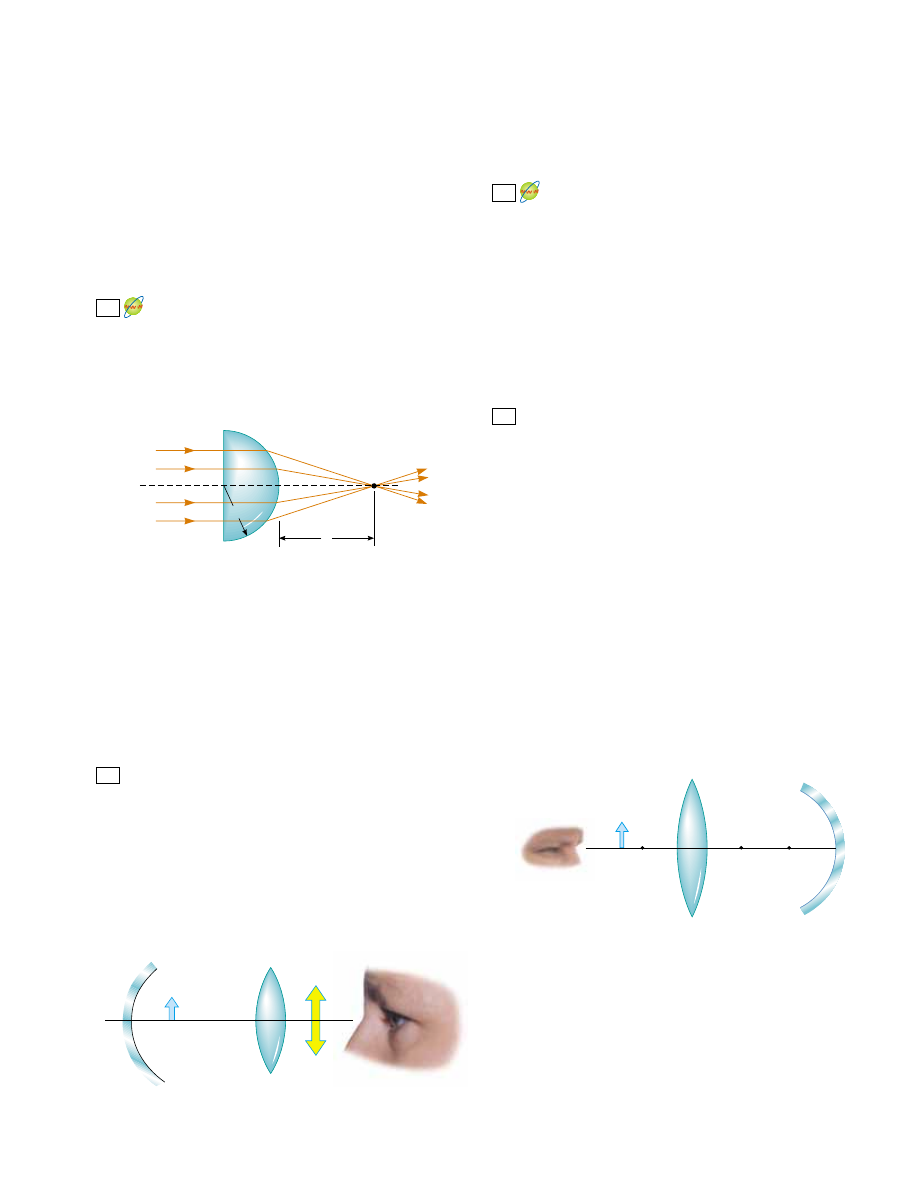Physics For Scientists And Engineers 6E - part 294

Problems
1173
63. An object placed 10.0 cm from a concave spherical mirror
produces a real image 8.00 cm from the mirror. If the object
is moved to a new position 20.0 cm from the mirror, what is
the position of the image? Is the latter image real or virtual?
64.
In many applications it is necessary to expand or to
decrease the diameter of a beam of parallel rays of light.
This change can be made by using a converging lens and a
diverging lens in combination. Suppose you have a con-
verging lens of focal length 21.0 cm and a diverging lens of
focal length $ 12.0 cm. How can you arrange these lenses
to increase the diameter of a beam of parallel rays? By
what factor will the diameter increase?
A parallel beam of light enters a glass hemisphere
perpendicular to the flat face, as shown in Figure P36.65.
The magnitude of the radius is 6.00 cm, and the index of
refraction is 1.560. Determine the point at which the beam
is focused. (Assume paraxial rays.)
65.
and the other is inverted. Both images are 1.50 times larger
than the object. The lens has a focal length of 10.0 cm. The
lens and mirror are separated by 40.0 cm. Determine the
focal length of the mirror. Do not assume that the figure is
drawn to scale.
The disk of the Sun subtends an angle of 0.533° at the
Earth. What are the position and diameter of the solar
image formed by a concave spherical mirror with a radius
of curvature of 3.00 m?
70.
Assume the intensity of sunlight is 1.00 kW/m
2
at a particu-
lar location. A highly reflecting concave mirror is to be
pointed toward the Sun to produce a power of at least 350 W
at the image. (a) Find the required radius R
a
of the circular
face area of the mirror. (b) Now suppose the light intensity is
to be at least 120 kW/m
2
at the image. Find the required
relationship between R
a
and the radius of curvature R of the
mirror. The disk of the Sun subtends an angle of 0.533° at
the Earth.
In a darkened room, a burning candle is placed 1.50 m
from a white wall. A lens is placed between candle and wall
at a location that causes a larger, inverted image to form
on the wall. When the lens is moved 90.0 cm toward the
wall, another image of the candle is formed. Find (a) the
two object distances that produce the specified images and
(b) the focal length of the lens. (c) Characterize the
second image.
72.
Figure P36.72 shows a thin converging lens for which the
radii of curvature are R
1
"
9.00 cm and R
2
" $
11.0 cm.
The lens is in front of a concave spherical mirror with
the radius of curvature R " 8.00 cm. (a) Assume its
focal points F
1
and F
2
are 5.00 cm from the center of
the lens. Determine its index of refraction. (b) The lens
and mirror are 20.0 cm apart, and an object is placed
8.00 cm to the left of the lens. Determine the position of
the final image and its magnification as seen by the eye
in the figure. (c) Is the final image inverted or upright?
Explain.
71.
69.
n
R
Air
I
q
Figure P36.65
66.
Review problem. A spherical lightbulb of diameter 3.20 cm
radiates light equally in all directions, with power 4.50 W.
(a) Find the light intensity at the surface of the bulb.
(b) Find the light intensity 7.20 m away from the center of
the bulb. (c) At this 7.20-m distance a lens is set up with its
axis pointing toward the bulb. The lens has a circular face
with a diameter 15.0 cm and has a focal length of 35.0 cm.
Find the diameter of the image of the bulb. (d) Find the
light intensity at the image.
An object is placed 12.0 cm to the left of a diverging lens
of focal length $ 6.00 cm. A converging lens of focal
length 12.0 cm is placed a distance d to the right of the di-
verging lens. Find the distance d so that the final image is
at infinity. Draw a ray diagram for this case.
68.
An observer to the right of the mirror–lens combination
shown in Figure P36.68 sees two real images that are the
same size and in the same location. One image is upright
67.
Object
Mirror
Lens
Images
Figure P36.68
F
2
C
F
1
Figure P36.72
73.
A compound microscope has an objective of focal length
0.300 cm and an eyepiece of focal length 2.50 cm. If
an object is 3.40 mm from the objective, what is the
magnification? (Suggestion: Use the lens equation for the
objective.)
74.
Two converging lenses having focal lengths of 10.0 cm
and 20.0 cm are located 50.0 cm apart, as shown in